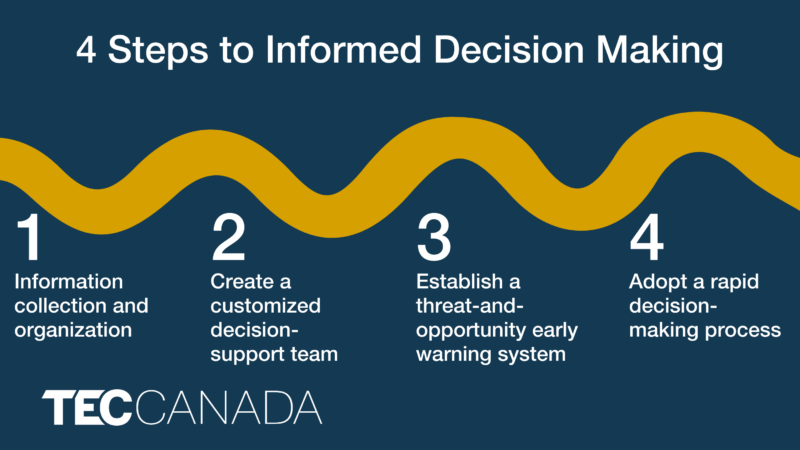4 Steps to Making Informed Decisions for Business Leaders
A leader’s job description is to make tough decisions. Finding the right information to base your decisions on can be overwhelming.
Aside from being in a peer group of business leaders to bounce ideas off, below are four organizational leadership strategies to support the best-informed decisions. Remember, this is chess, not checkers.
1. Information collection and organization
• Analyze data and information that applies to a challenge
Once information is collected, the next step is to filter and prioritize it. This means sifting through to identify the most important insights. A marketing team might analyze customer feedback, sales data, and market trends before they make an executive decision to launch a new product. This might involve creating a SWOT or cost-benefit analysis that outlines the pros and cons of the decision.
The goal is to distill information into clear, actionable insights that support or refute the decision. Choices should be made based on solid evidence rather than intuition or incomplete information.
• Extract and categorize best practices
Organizations should seek out best practices from learned experiences or case studies to further enhance decision-making. A software development company might create a database of coding standards, successful project case studies, and troubleshooting guides.
By categorizing this information into categories such as ‘quality assurance,’ or ‘client communication,’ employees can access it when facing similar challenges. This database can be a valuable resource for new and experienced employees, helping them to avoid repeating mistakes and to build on proven strategies.
2. Create a customized decision-support team
• Provide access to specialists who can provide expert advice and counsel
To ensure decision-making is robust, it’s crucial to have access to specialists who can offer expert advice. When a company wants to enter a new market, it could consult legal experts to learn about local laws. Marketing specialists too can help understand the cultural nuances of the new audience.
Through an internal team or consultants, having these specialists available can help make decisions that are aligned with strategic goals. This approach reduces the risk of costly mistakes and ensures that the decision-making process is backed by the best possible expertise.
• Foster a culture that promotes collaborative leadership and systematic approaches
Building and maintaining a collaborative and supportive culture and working environment takes time with the right people in the right positions. A common saying is that an organization is an extension of its leader; the culture will reflect the characteristics of the owner/CEO. With that being said, it is important to carry yourself in a productive, open, systematic, and professional manner, if that is the culture you’d like to bring to your company.
When it comes time to make a big decision, the company culture will ensure that employees understand one another and the quality and collaboration expected of them.
3. Establish a threat-and-opportunity early warning system
• Identify and monitor significant challenges and opportunities
In today’s fast-paced business environment, staying ahead requires continuously identifying and monitoring changes in the market. For example, a retail company might use market intelligence tools to monitor competitor pricing strategies, consumer behaviour trends, and new technologies in e-commerce. By keeping a close watch on these factors, the company can proactively adjust its strategies, whether that means adopting new technologies, entering new markets, or refining its crisis response.
4. Adopt a rapid decision-making process
• Define a process that works well with repetitive and unexpected business decisions
To effectively manage both repetitive and unexpected critical decisions, it’s important to define a decision-making process that is flexible yet structured. This process should include clear steps for gathering information, evaluating options, consulting with stakeholders, and implementing decisions. For instance, a manufacturing company might make a process for addressing quality control issues, which could include steps like immediate investigation, cross-departmental communication, and a predetermined action plan for various scenarios. However, the process should also be adaptable to handle unexpected events, such as a sudden supply chain disruption.
By having a well-defined but flexible process, the company can respond quickly and consistently to both routine and unforeseen challenges.
• Optimize the process based on the size and type of your business
Process optimization for decision-making requires tailoring it to fit the size and type of your business. A small startup, for instance, might need a more agile and informal process where decisions can be made quickly by a few key people. A large corporation may require a more formalized and hierarchical process involving multiple levels of approval and documentation. Consider a tech startup that relies on rapid innovation; the decision-making process should be streamlined by business leaders for quick pivots and rapid development cycles.
On the other hand, a multinational corporation might optimize its process with detailed reports, multi-stage approvals, and risk assessments to ensure that decisions align with long-term strategic goals and compliance requirements. By optimizing the decision-making process to suit the business’s unique needs, organizations can reduce bottlenecks and enhance the overall effectiveness of their decisions.
• Evaluate the existing situation and apply the best available resources
Effective decision-making requires prioritizing choices and minimizing risks to avoid negative consequences. This involves a thorough evaluation of the current situation, identifying the most pressing issues, and allocating the best available resources to address them. For example, in a crisis such as a data breach, a company might prioritize actions like securing the breach, communicating with stakeholders, and restoring services based on the severity and impact of each task.
By using a triage approach, the company can focus its resources on the most critical areas first, minimizing potential damage, and ensuring a swift and effective response. This approach is also valuable in everyday decision-making, where evaluating risks and prioritizing tasks can help prevent issues from escalating and ensures that the most important decisions are addressed promptly and effectively.
The judgment of an executive is only as good as their information and how they empower their team. Business leaders depend on informed decision-making. To bolster up your leadership development, fill in the form below to keep your business from becoming the Kodak of your industry.
Become A Member
"*" indicates required fields





